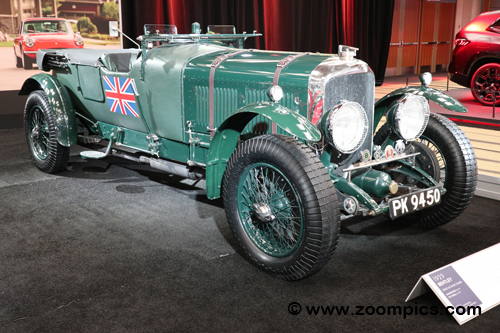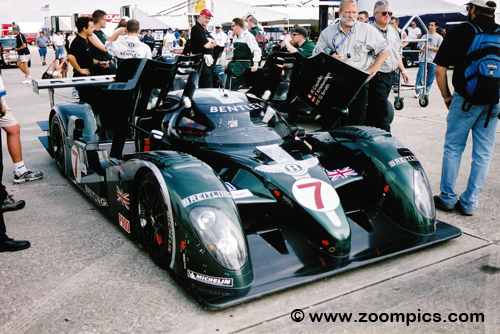

|
Bentley Motors was founded by Walter Owen Bentley on July 10, 1919. Bentley's mission was to build good, fast, and best-in-class cars.
At the end of WWI, Bentley and a group of engineers developed an advanced three-liter, four-cylinder engine. The motor was used in the company's first prototype, EXP1. Bentley was passionate about racing and believed motorsports elevated his car's status, attracting wealthy buyers.
|
| Between 1923 and 1930, Bentleys entered the 24 hours of Le Mans and were victorious five times in seven years. The team's highlight was 1929, when Bentleys were the top-four finishers. Woolf Barnato shared the Bentley Speed Six, and Sir Henry 'Tim' Birkin led the charge. The pair won by seven laps and set a new race distance record, covering over 2,800 km. |

|

|
The 1929 Bentley Speed Six is powered by a 6.5-liter 6-cylinder single overhead camshaft motor with four valves per cylinder. The normally aspirated engine is supplied air and fuel through two SU carburetors and has an output of 200 horsepower. The motor is mounted to a ladder frame. The suspension consists of leaf springs with friction dampers. Four drum brakes stop the Speed Six. |
| After a 68-year absence, Bentley returned to Le Mans with the EXP Speed 8. The car was designed by Peter Elleray and manufactured by Racing Technology Norfolk. The team won the LMPGT category and finished seventh overall. They were classified as eleventh the following year and grabbed another class victory. In 2003, Team Bentley returned to the US after 81 years. |

|
|
|
In 1922, WD Hawkes drove a near-standard 3-liter Bentley at the Indianapolis 500 and crossed the finish line in thirteenth place after starting nineteenth and completing all 200 laps. At the 2003 12-Hours of Sebring, the team entered two Bentley Speed 8s to compete in the LMPGT category. The fifty-first running of this event would serve as a test for later in the season when Team Bentley went to Le Mans. |
| 1929 Bentley Speed Six Sport | 2003 Bentley Speed 8 | |
| CHASSIS | Pressed steel, ladder frame | Carbon-Fiber monocoque |
| ENGINE | In-line, 6-cylinder, four valves per cylinder, single overhead camshaft, normally aspirated | 90 degree V8, four valves per cylinder, twin overhead camshafts, twin turbochargers |
| FUEL DELIVERY | Two SU carburetors | Bosch 2.8 engine management |
| LUBRICATION | Wet Sump | Dry Sump |
| CAPACITY | 6.5-liter | 4.0-liter |
| POWER OUTPUT | 200bhp | Over 600bhp |
| WEIGHT | 990 kg | 900 kg |
| The 2003 Bentley Speed 8 evolved from the EXP Speed 8 model, which was also designed by Peter Elleray. The car was manufactured by Race Technology Norfolk and maintained by Audi Sport UK under the Team Bentley banner. Initially, it was thought that the new Bentley was an Audi R8 with a roof and different bodywork, but nothing could be further from the truth. The only common feature of both cars is the engine. |
|
|
|
Bentley's chassis is a carbon-fiber and aluminum honeycomb monocoque with a carbon roll hoop integrated into the roof structure. The front and rear suspensions use independent double wishbones, pushrods, and torsion bars. Steering is accomplished through a Kayaba EPS power-assisted rack and pinion. |
| Race Technology Norfolk stressed carbon fiber for the body. Aerodynamics was important in the new design, as more air was needed to reach the rear wing. To meet this requirement, the air intake that sat on the top of the EXP model was replaced with snorkel-type intakes on the side of the Speed 8. The result was a more favourable downforce-to-drag ratio. |
|
|
|
The engine used is the 4.0-liter unit found in the Audi R8. This is a 90-degree V8 with four valves per cylinder and twin overhead camshafts. The motor is equipped with twin turbochargers and a Bosch 2.8 engine management system for fuel delivery and ignition requirements. Power to the rear wheels is transferred through an Xtrac 6-speed sequential transmission with Megaline pneumatic actuation. |
| Stopping the Bentley Speed 8 are 14.8-inch diameter ventilated rotors with AP six-piston racing calipers on the front. The rear is fitted with 14-inch diameter ventilated rotors using the same calipers as the front. The car rides on Michelin tires mounted on 18-inch forged magnesium OZ wheels. The 900 kg LMPGT class car can achieve a top speed of over 215 mph. |

|
|
|
Team Bentley hired six drivers for its 2003 assault on Le Mans. Rinaldo Capello, Tom Kristensen, and Guy Smith piloted the No. 7 Bentley Speed 8. Capello and Kristensen had extensive experience with Audi Sport North America and Team Joest. The duo had a pair of victories at the 12-Hours of Sebring, and Kristensen also had four wins at Le Mans. Smith has been with the team since 2001. His background includes a lot of open-wheel racing. |
| The No. 8 Bentley Speed 8 line-up was Johnny Herbert, Mark Blundell and David Brabham. Herbert has an impressive racing resume, including seven Formula 1 podiums, of which three are victories. His Le Mans record includes a win in 1991. Blundell has sixty-one Formula 1 starts and competed in the CART series, earning three victories. Brabham also has Formula 1, making twenty-four starts during his career. |
|
|
|
Team Bentley's goal for 2003 was victory at Le Mans. However, after miles of testing, it was time to enter the cars in a competitive event. The 12 Hours of Sebring would be an excellent opportunity to see if the cars and team were ready for Le Mans. Rinaldo Capello, Tom Kristensen, and Guy Smith shared the No. 7 Bentley Speed 8 for the endurance classic. The trio of Mark Blundell, David Brabham, and Johnny Herbert handled the No. 8 Bentley. |
| The Team Bentley demonstrated their speed in the opening practice session and did the same in qualifying. The Bentleys would capture the front row, with Johnny Herbert in the No. 8 entry winning the pole. Unfortunately, the cars failed the technical inspection and were put to the rear of the grid. The cause was a rear diffuser infraction, which was corrected for the race. They started in positions forty and forty-one. |
|
|
|
The team charged to the front but was unable to catch the two Audis. The trio of Johnny Herbert, David Brabham, and Mark Blundell, driving the No. 8 Bentley Speed 8, finished four laps behind the overall winners, Marco Werner, Frank Biela, and Philipp Peter, in third position. They won the LMPGT category; however, Team Bentley were the only entries. The second car finished fourth, five laps behind the winners. |
| The 24 Hours of Le Mans was an opportunity for the team to redeem themselves, and they did. As was the case at Sebring, they swept the front row and passed the qualifying technical inspection. The No. 7 Bentley Speed 8, driven by Rinaldo Capello, Tom Kristensen, and Guy Smith, earned the overall and class victory. Finishing second, but two laps behind them were their teammates, Mark Blundell, David Brabham and Johnny Herbert. |
|

| YEAR | ENTRANT | NO. | DRIVER | CLASS | LAPS | POS. | CLASS POS. |
|---|---|---|---|---|---|---|---|
| 2003 | Team Bentley | 8 | Mark Blundell David Brabham Johnny Herbert |
LMGTP | 363 | 3 | 1 |
| 7 | Rinaldo Capello Tom Kristensen Guy Smith |
LMGTP | 362 | 4 | 2 |
| YEAR | ENTRANT | NO. | DRIVER | CLASS | LAPS | POS. | CLASS POS. |
|---|---|---|---|---|---|---|---|
| 2003 | Team Bentley | 7 | Rinaldo Capello Tom Kristensen Guy Smith |
LMGTP | 377 | 1 | 1 |
| 8 | Mark Blundell David Brabham Johnny Herbert |
LMGTP | 375 | 2 | 2 |

| Copyright Notice: |
| All content (photographs and text) appearing on this website are the exclusive property of © www.zoompics.com and are protected under International copyright laws. The subject matter on this website may not be reproduced, copied, stored or manipulated. |